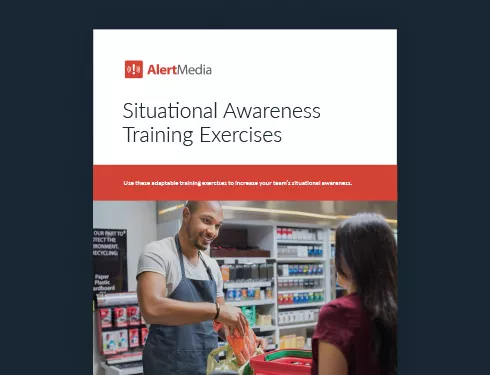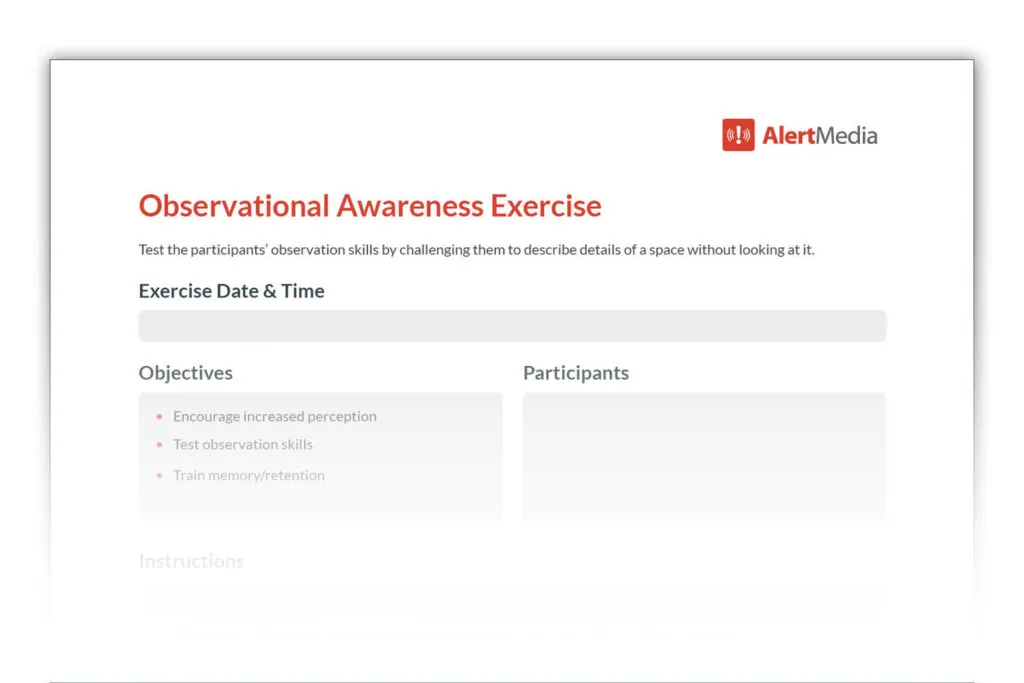
10 Situational & Safety Awareness Tips for the Workplace
To prevent a wide range of hazards, promote situational awareness at all levels of your organization. These expert tips will help you build a foundation of proactive safety awareness.

In fast-paced and potentially hazardous work environments, it‘s critical to maintain a sharp sense of awareness. Whether you’re staying aware of hazards in your physical environment or hazards related to the people around you, situational and safety awareness can be a lifesaving skill for employees.
Situational Awareness Training Exercises
We spoke with Jonathan Arnburg on The Employee Safety Podcast about threats to business resilience in healthcare where lives are at stake. Jonathan is System Senior Director of Public Safety and Emergency Management at Inova, Northern Virginia’s leading nonprofit healthcare provider. “For our clinical providers or support services, we teach them the techniques to read people’s body language so they can see when a person is starting to escalate. They can be aware of their surroundings.” Jonathan explained how he trains his team to stay vigilant. Not everyone wants to necessarily blow up or escalate, but sometimes it happens. So if our team can identify that and preemptively de-escalate the situation, it works out in everybody’s favor.”
In this article, we’ll outline ten key tips on how to improve situational awareness for safety in the workplace. You can also download these situational awareness training exercises to help your team prepare to stay safe and alert on the job.
Preview of our Situational Awareness Training Exercises template
10 Expert Situational Awareness Safety Tips for the Workplace
1. Adopt a structured situational awareness framework
Everyone has a slightly different approach to staying aware, with unique ways of collecting and processing information. But in the workplace, you need your entire team to operate on the same wavelength. A company’s situational intelligence depends on the ability to understand, detect, and mitigate dangerous scenarios in a consistent fashion.
Unsurprisingly, the military has developed and refined common frameworks for honing quick decision-making to the point of being second nature:
The OODA loop
Developed by a U.S. Air Force strategist for fighter pilots, the OODA loop is a process to assess confusing or rapidly evolving situations.
- Observe the situation
- Orient yourself to the reality of your surroundings, eliminating your assumptions and biases
- Decide what you’re going to do
- Act confidently with your ongoing awareness for safety
The SLAM technique
Much like the OODA loop, the SLAM technique consists of four steps.
- Stop and think before proceeding
- Look around your work environment for safety hazards
- Analyze the risks present and whether you’re prepared for them
- Manage the situation, and if necessary, halt work until you can mitigate the risks
Neither framework is inherently better than the other. Evaluate which model is a better fit for your organization’s needs, and incorporate it into situational awareness training so your employees have practice with the method.
Examples of situational awareness in the workplace
Conditions impacting safety vary widely by industry. But workplace situational awareness always boils down to one essential concept—keeping track of risks in the work environment and responding to them appropriately.
Here are some situational awareness safety examples on the job:
- Truck drivers need to watch out for hazards that could lead to an accident, such as inclement weather, unsafe drivers in surrounding lanes, or debris on the road
- Line cooks have to constantly be aware of hot surfaces, practice safe knife skills, and watch out for their coworkers in a crowded kitchen
- Forklift operators are responsible for maintaining a reasonable speed, safely balancing the loads they’re carrying, and watching for people or objects in their path
- Construction workers must understand the dangers of the tools they use, communicate with others who are running heavy machinery, observe safety protocols for heights or falling debris, and practice proper lifting techniques
- Office workers must be wary of cunning cyber threats, cautious of potentially dangerous situations in the parking lot, and responsible with kitchen appliances and other electrical equipment
2. Stay focused & pay attention
Life is full of distractions. Most of us have long to-do lists, notifications beeping all day long, and the constant stimuli of people interacting with us.
Distractions might seem like a minor annoyance, but they can be a significant hazard in the workplace. If you make a mistake working on a spreadsheet because you’re multitasking, it could have serious consequences for business operations. Ideally, you recognize the mistake in time to reload the file. However, power tools and heavy equipment don’t have an undo button.
There are a few ways to promote focus in the workplace:
- Limit electronic device usage: Some workplaces already prohibit cell phones for security reasons. You can also consider implementing policies on when and where they’re permitted.
- Discourage multitasking: When you have too much to do, tackling several things at once is tempting. However, research has shown that most people are actually less efficient when multitasking. Thus, multitasking can decrease the quality of work and increase the risk of mistakes or worse, injuries.
- Manage disruptions: Employees who work with heavy equipment or dangerous substances—or are otherwise responsible for safety or operational continuity—need absolute focus. Establish distraction-free zones where only supervisors have the authority to interrupt the work process.
What is safety awareness?
Safety awareness is the process of staying alert to potential hazards and risks in various environments and keeping safety measures and precautions in mind. It involves active situational awareness, paying attention to your surroundings, promoting caution, and adhering to safety protocols to minimize accidents and ensure the well-being of everyone around.
3. Watch for fatigue
How many times have you started the day more tired than usual, compensating with an extra cup of coffee? It might seem harmless, but fatigue is a serious hazard that can cause slower reaction times, impaired judgment, and difficulty concentrating.
Even if workers are getting their requisite seven or more hours of sleep per night, other environmental factors can have an impact. Stress, heat, and overexertion—both physical and mental—can all lead to fatigue. At best, fatigue can lead to near misses that wake you right up. At worst, it can cause accidents involving physical and/or financial damages.
Unfortunately, it’s not always easy for someone to assess their own level of fatigue. Train your employees to recognize the signs in their team members and know when someone isn’t fit to be working. Additionally, it’s important to frame the process as safety-oriented, rather than disciplinary. No one wants to get their friend in trouble, but they wouldn’t hesitate to protect their buddies from getting hurt.
Bonus tip: Maintain a positive safety culture that values situational awareness safety
It’s easy for “safety” to slip into a pattern of forced compliance, with employees doing the bare minimum to avoid getting written up, supervisors focusing on rules and risks only when they absolutely have to, and inspectors walking around with clipboards, noting mistakes and quietly shaking their heads. When the process boils down to checking a box, nobody wins.
Instead, focus on building a positive safety culture. Adopt safety as one of your company’s core values, and act accordingly:
- Weave safety into every aspect of employee training, from onboarding to monthly safety meetings to team-building exercises—to improve every employee’s level of situational awareness
- Promote company-wide buy-in by ensuring leaders are committed to safety
- Develop messaging that casts preparation, planning, and decision-making processes as proactive rather than reactive
- Provide actionable feedback to help your team keep themselves and their peers safe in the workplace
4. Be vigilant
One of the primary components of risk awareness is identifying subtle hazards. Anyone can tell you that an overflowing toilet or an active fire is dangerous. However, spotting and managing the little things can be the key to preventing disaster.
No one is more familiar with your workplace than your employees. They know the space, their coworkers’ tendencies and body language, and the nuances of what’s going on around them. They will be more easily able to spot when something is wrong. Empower your frontline workers to share their gut feelings and speak up when something seems off. It’s better to investigate a potential risk and discover it was nothing than to ignore it and let it develop into a serious hazard.
5. Promote good mental health at work
Workplace mental health can have a larger impact on occupational health and safety than most people realize. Employees with poor mental health or those who don’t feel psychologically safe at work are more likely to make unsafe decisions or fail to report hazards. This can be because they are less able to maintain awareness safety or because they don’t believe their concerns will be taken seriously.
Train your team to identify potential red flags related to their mental health and their teammates’ to help prevent potential hazards, including burnout and even workplace violence. When your organization promotes good mental health, you are not only supporting your employees’ well-being; you’re also promoting a safer workplace overall.

6. Encourage clear and thorough communication
When you do the same task day after day, it can be easy to become complacent. You may assume your coworkers know what’s going on, confident that they’re aware of the same safety hazards and risks as you. But assumptions and situational awareness don’t play nicely together.
Teach your employees to communicate clearly and thoroughly, no matter how routine things might seem. The practice of verbally calling out hazards ensures everyone is cognizant of the situation, taking it seriously, and working to keep each other safe.
A robust two-way communication system can also simplify and optimize your company-wide safety efforts. Make sure your team has access to emergency notifications, and train them on how and when to report hazards to the right personnel.
7. Use visual and auditory signaling devices
In loud and fast-paced environments, the details of conversations or instructions can get lost. You can pair verbal communication with visual and auditory signaling, especially when it highlights a potential hazard.
Some common examples of signals that promote situational awareness:
- Flashing lights on heavy machinery when it’s in operation
- Clear, loud beeping when vehicles such as trucks or forklifts are backing up
- Alarms when doors aren’t securely closed
- Brightly colored barriers, cones, or fences around non-obvious hazards like oil slicks, ice, or chemical spills
8. Host safety talks or safety moments
A great way to keep situational and safety awareness top of mind is to maintain consistent safety training. This is simple to do with short safety talks, toolbox talks, or safety moments. These mini safety meetings are a low-lift way to establish a consistent cadence of learning about safety best practices to supplement more comprehensive training. They are also a great way to demonstrate that safety is a top priority for your organization and enable your team to make decisions about potential dangers at work and in everyday life.
Focus on one safety topic per meeting and incorporate interactive elements to engage people, so your team retains critical details. Here are some safety topics you can use for your safety talks:
- Identifying suspicious people
- Recognizing extreme heat- or cold-related stress and illness
- Self-defense
- Personal protective equipment (PPE)
- Signs of burnout and other mental health risks
- Relevant safety policies
- Emergency preparedness
- Preventing fire hazards
- What to expect from safety notifications and how to respond
9. Have an exit strategy
Thanks to OSHA requirements, every worksite has clear directions to emergency exits. And your company probably runs fire drills to ensure everyone knows how to safely get out of the building.
However, an exit strategy is more than simply identifying a door or path to safety. In many cases, it’s having a plan of action if something goes wrong. For example, if you’re operating heavy equipment and it malfunctions, what steps do you take to protect yourself and your coworkers? How do you shut it down and alert the right contacts? And how do you exit the area if necessary?
Situational awareness focuses on detecting and understanding potential hazards. Not every problem can be avoided, though, and you always need an exit strategy. Risk intelligence bridges this gap. It comprises a continuous stream of planning from situational awareness and hazard prevention to evaluating realistic outcomes and responding to environmental dangers.
10. Practice and reinforce situational awareness
Most importantly, you need to reinforce situational awareness safety tips until they become second nature. It’s easy to make the right decision when you’re sitting in a peaceful environment, discussing your options. But when faced with a rapidly evolving threat, your employees need to be able to act on instinct to protect their personal safety.
Make safety awareness a monthly safety topic, both as a focused item and as a complement to other relevant discussions. Perform periodic situational awareness training and use tabletop exercises to help employees practice their skills. You can even conduct brief situational awareness safety moments regularly. Provide thorough feedback throughout the process, promoting a vigilant and proactive safety culture in the workplace.
Foster Workplace Safety With Strong Situational Awareness
The average work environment is full of potential threats. Many of them are inconsequential, easily managed, and can be dealt with before they cause harm. A frayed power cord might be nothing today, but in six months it could spark an overnight fire.
To prevent small issues from becoming real problems, your organization needs to promote situational awareness. Train employees to detect hazards in the workplace, understand the risks, and handle them before they become imminent threats. A hazard-free environment might not be possible, but when you make safety awareness a key part of your company’s culture, you can be confident your employees are looking out for each other’s well-being and contributing to a more resilient business.





